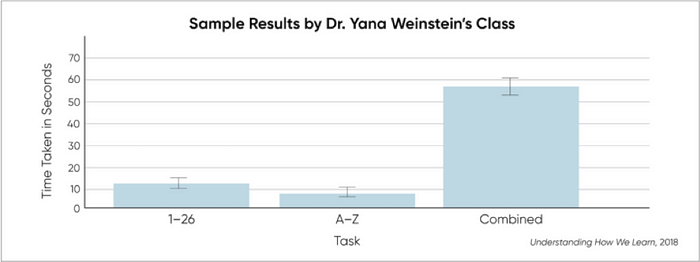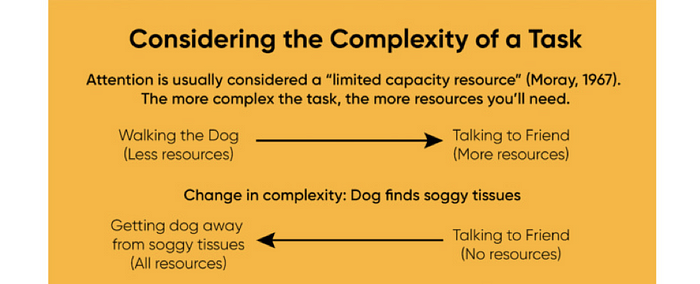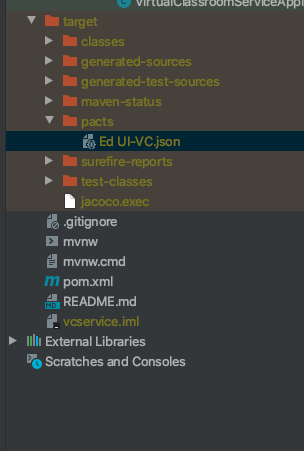Can We Multitask? Time Management Insights and Tips for You, Teachers & Learners
This post is part of a blog series on considering integrating learning sciences in K-12 edtech development. Read the introductory blog post in the series here. In a time when our all of our family members are working and playing in the same place, being interrupted and lack of productivity has come up a lot during this stressful time. I hope that this article about multitasking (which I originally wrote for teachers a few months ago) can be helpful for all you juggling multiple roles out there!

How many times in the last few months have you joined a call, wrapped up an email, responded to a child who yelled out a question, and then remembered you needed to defrost some chicken for dinner (and let’s be honest, there’s probably also some laundry running)? Then, all of a sudden, you realize that the silence on the call is because folks are waiting for you to answer a question? Then you need to ask, “could you please repeat that?” Although a number of things were happening at once, your attention was actually only on one of those tasks at a given time. As a learning scientist, I know that when I wash the dishes while I’m cooking, I’m really task-switching rather than multitasking. Although we all attempt to multitask, the concept that we can pay attention to two things at the same time is a myth.
Like the teachers we serve with educational technology, time is probably your most precious resource and while working at home we are expected to be master multitaskers. Researcher Philip Jackson estimates that elementary teachers have 200 to 300 interactions with students every hour, resulting in an average of 1,200 to 1,500 decisions each day! Teachers play many roles — administrator, information provider, assessor, discipline controller, facilitator, role model, and even foster parent. Fortunately, educational technology is helping them out. In HMH’s 2019 Educator Confidence Report, conducted in collaboration with YouGov, more than one-third of teachers indicated the time-saving benefits of technology for delivering instruction and streamlining workflows and processes. However, technology in the classroom may also distract students and teachers to some degree, creating frequent and unexpected task-switching that’s detrimental to learning outcomes.
I recently dug into research on attention and learning to find out more, and I want to share what I learned regarding the truth about multitasking, as well as some strategies to create effective learning experiences for learners.
What the Research Says About the Multitasking Myth
In Understanding How We Learn: A Visual Guide, Weinstein and Sumeracki, with Caviglioli (2018) dedicate a section of the chapter focused on attention to the “Myth of Multitasking.” They explain that it’s critical to acknowledge that we can only actually pay attention and process information from one stimulus at a time. The authors add that even though our intuition may tell us otherwise, research shows that “switching between two tasks decreases efficiency and slows down reaction speeds in both tasks.”
In the chapter, they propose conducting a study with your students (or for you, perhaps your coworkers!) to demonstrate the impact of task-switching on performance using three tasks and see how long each takes.
- Task 1: Counting from 1–26
- Task 2: Reciting the alphabet from A-Z
- Task 3: Switching back in forth between letters and numbers, 1-A-2-B-3, and so on.
You should find that Task 3 takes more than twice as long as Task 1 or Task 2. Although we are not intentionally designing tasks sets such as this example, the exercise makes me think about the potential for distractions in the classroom, especially during tech-enhanced activities.

In their paper about media multitasking, Professors Kaitlyn May and Anastasia Elder (2018) review different theories of attention that suggest our attentional resources are limited. The more complex a task is, the more resources it uses. When two complex tasks are present at once, there’s an attention bottleneck, and only one task will win your attention.

You may be thinking, I can do multiple simple things at once with no problem! The most common, perhaps simple, thing demanding our attention in today’s world is our phone. Researchers are still learning about the possible negative impacts of intense tech-enabled task-switching on learning.
An interesting study by Rosen, Lim, Carrier, and Cheever (2011) about in-class mobile phone usage revealed that during a college course lecture, the more text interruptions students experienced, the more their end-of-class test grade suffered. These were college students, and perhaps as adults we think that we would be more self-reflective and considerate about the impact of text messages on attention.
Why We Should Listen to the Multitasking Research
This myth seems to be so sticky because the positive feelings associated with the illusion of multitasking contradicts the more accurate and negative longer-term impact of task-switching. When we task-switch, neuroscience research shows that we are understanding the information that we are engaging with through a secondary, less-reliable memory system. Unfortunately, this system does not effectively support memory storage and retrieval. We all must be wary of little, non-important things that may be interrupting us when you are trying to do something important.
Another complex emotional aspect of task-switching is that when we make the decision to work on multiple tasks at the same time, we optimistically think we will save time and get extra checks on our to-do lists. This productivity-reward cycle would then lead us to continue to plan for and then task-switch again. Researchers have shown that when we think we are good at multitasking we do it more often. Unfortunately, the negative impacts related to quality or long-term learning can be difficult, if not impossible, to see in the moment.

One temptation to task-switch is tech-related distractions — something you (and our teachers and learners) probably deal with constantly! The dinging of those notifications are Pavlovian cues that make it nearly impossible not to look or at least think about what the dinging could be. It doesn’t bother us when we get distracted by our own phone, but it can be very annoying when our friend’s phone distracts her from your conversation (one such study examined the impact of phones on relationships). This lack of concern or perhaps awareness of our own distraction is probably what concerns me the most.
Tips to Prevent and Reduce Task-Switching
I admit, even if I have every intention in the world of staying focused, I often get distracted or task-switch way too often. Here are some of the research-based techniques that I’ve used to stay focused and on task — even writing this blog post!
Tip #1: Set a timer for 25 minutes and focus on just one task.
With the Pomodoro Method, explained here by Dr. Lucy English, you set a timer for 25 minutes to focus on just one task — say, investigating a better way to use a certain tool — and then take a five-minute break before going on to the next task.
Tip #2: Schedule and take advantage of guaranteed uninterrupted time
When you know you have an hour or two of focus time, block it off (no meetings!) for your most important or complex tasks. Schedule that time for when you feel most productive, whether that be first thing in the morning or later in the day.
Tip #3: Increase awareness by collecting data about how you are spending your time.
I recently used time-keeping software to track how long my tasks were taking. The first thing I noticed is that I spend a lot more time planning than I thought I did! More than anything, I found that the act of tracking my time forced me to reflect on what I was doing and answer the critical question: Was that time spent doing important work that supports my short- and long-term goals?
Tip #4: Leverage the settings on your devices to keep tech-enhanced distractions at bay.
To help you regulate, turn off notifications and your Wi-Fi and use comments to mark placeholders to look things up later.
What to Think About When Designing Lessons for Learners
Let’s use our HMH Learning Science Pillars (RAMP: Rigorous, Aligned, Motivating, and Personal) to zoom in on how we reduce distractions to enable deep learning for our learners.

RIGOROUS
Learners’ minds may wander when they are not responsible for actively engaging with the material. Online lessons should include complex thinking and interactive activities to continuously direct learners’ attention toward the tasks at hand. Multiple opportunities to recall and demonstrate the information will also support longer-term learning. If learners can chat with a friend or work with a family member, turn-and-talks or think-pair-shares can refresh learners’ attention and allow peers to support each other’s interaction with the information stream.
ALIGNED
To avoid accidental task-switching, be sure that all of the instruction, practice, and assessment are aligned with the learning objectives. Remember that there’s a cost to switching attention back and forth from the task at hand. If you are changing topics, give your learners a “brain break” to put some space in between the tasks and replenish their capacity to focus when they start working again. HMH’s Waggle recently created a Story Mode feature, where students play a “choose your own adventure” story for 5 minutes in between lessons.
MOTIVATING
To help keep learners’ attention focused, ask important and relevant questions about the material throughout the lesson. These should be questions that the learners should be able to answer if they are following along. Not only will this technique keep the lesson interactive, but it can also boost their motivation by knowing that they are keeping up with the lesson.
PERSONAL
Targeted icons or progress indicators can be very helpful to support learners to self-awareness and provide reminders to use self-regulation skills. During a live online course, sign language acts as a silent cue to direct or redirect a learner’s attention and reinforce desired behavior, without distracting or interrupting other learners in the class. Teaching learners some signs to communicate back with the teacher about how they are feeling or what they need supports student-teacher connectedness (a critical predictor of student outcomes).
RAMP-Friendly Resource
I found one of the best education-focused summaries of the multitasking myth in the book Five Teaching and Learning Myths — Debunked: A Guide for Teachers by Adam M. Brown and Althea Need Kaminske. (They also close the book with a breakdown of the learning styles myth.) As an educator and psychologist, the authors team up to share tools and resources to help battle the multitasking trap.
Sample Strategy for Early Elementary School (excerpt from Five Teaching and Learning Myths Debunked):
Break Tasks Into Pieces: This method of instruction allows students to have material geared toward their needs. Throughout an assignment or lesson, have the student focus [on completing] a part of the task, then take a break, and come back to finish the task. This method increases productivity of the student by allowing the student to focus on a small portion of the assignment at a given time.
Remember, multitasking can be a hard habit to break. With a little planning ahead, you can organize your tasks, arrange your schedule, and set up your devices to help you to produce your best work. For students, keep learning interactive, focused on the learning objectives (with brain breaks), relevant to the tasks at hand, and in a format that supports self-regulation. I put out a lot of suggestions here! Be agile and choose one or two areas of focus at a time. I hope that HMH’s Learning Sciences Pillars RAMP can help you consider how to better tailor EdTech for learners.










